2012 TOYOTA YARIS HYBRID steering
[x] Cancel search: steeringPage 561 of 704
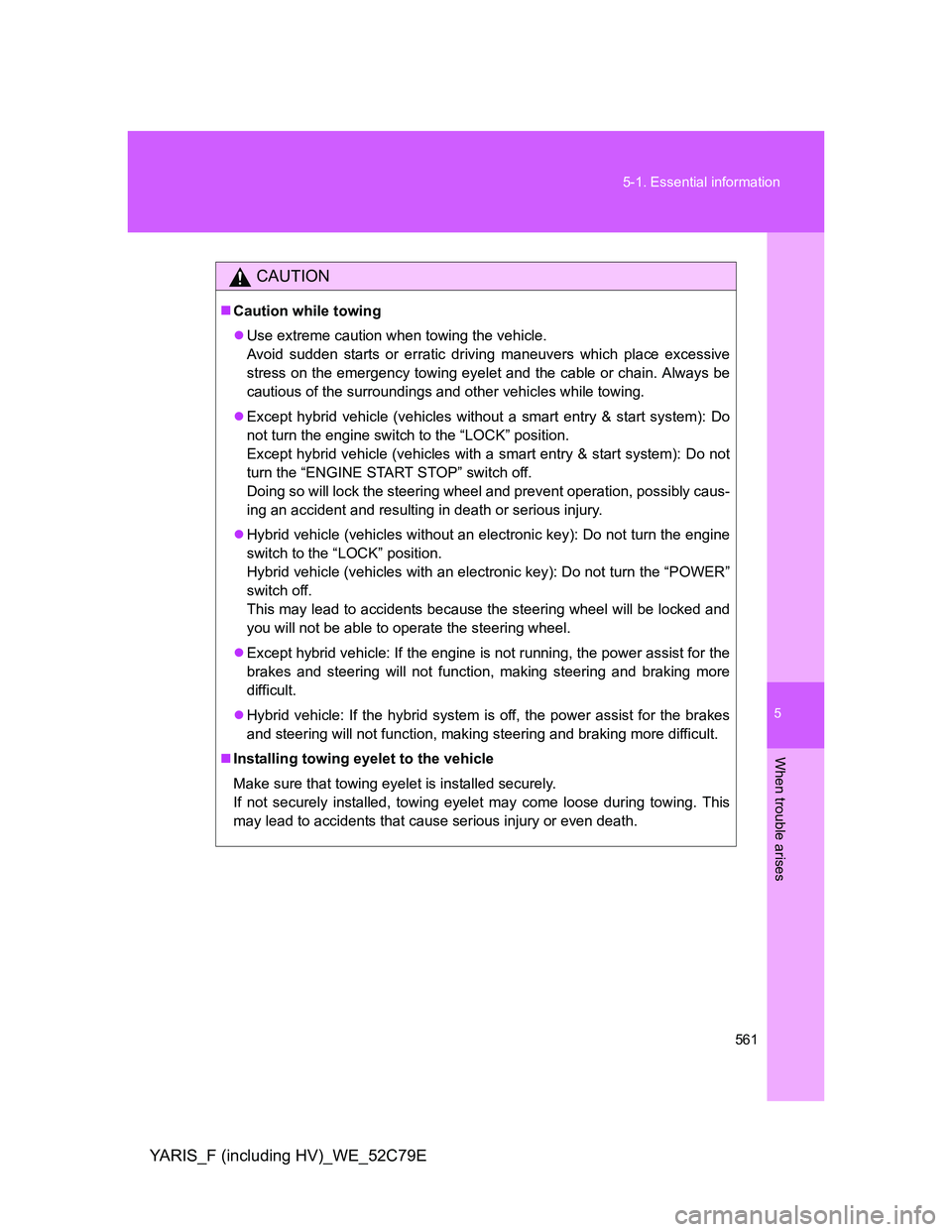
5
561 5-1. Essential information
When trouble arises
YARIS_F (including HV)_WE_52C79E
CAUTION
Caution while towing
Use extreme caution when towing the vehicle.
Avoid sudden starts or erratic driving maneuvers which place excessive
stress on the emergency towing eyelet and the cable or chain. Always be
cautious of the surroundings and other vehicles while towing.
Except hybrid vehicle (vehicles without a smart entry & start system): Do
not turn the engine switch to the “LOCK” position.
Except hybrid vehicle (vehicles with a smart entry & start system): Do not
turn the “ENGINE START STOP” switch off.
Doing so will lock the steering wheel and prevent operation, possibly caus-
ing an accident and resulting in death or serious injury.
Hybrid vehicle (vehicles without an electronic key): Do not turn the engine
switch to the “LOCK” position.
Hybrid vehicle (vehicles with an electronic key): Do not turn the “POWER”
switch off.
This may lead to accidents because the steering wheel will be locked and
you will not be able to operate the steering wheel.
Except hybrid vehicle: If the engine is not running, the power assist for the
brakes and steering will not function, making steering and braking more
difficult.
Hybrid vehicle: If the hybrid system is off, the power assist for the brakes
and steering will not function, making steering and braking more difficult.
Installing towing eyelet to the vehicle
Make sure that towing eyelet is installed securely.
If not securely installed, towing eyelet may come loose during towing. This
may lead to accidents that cause serious injury or even death.
Page 562 of 704
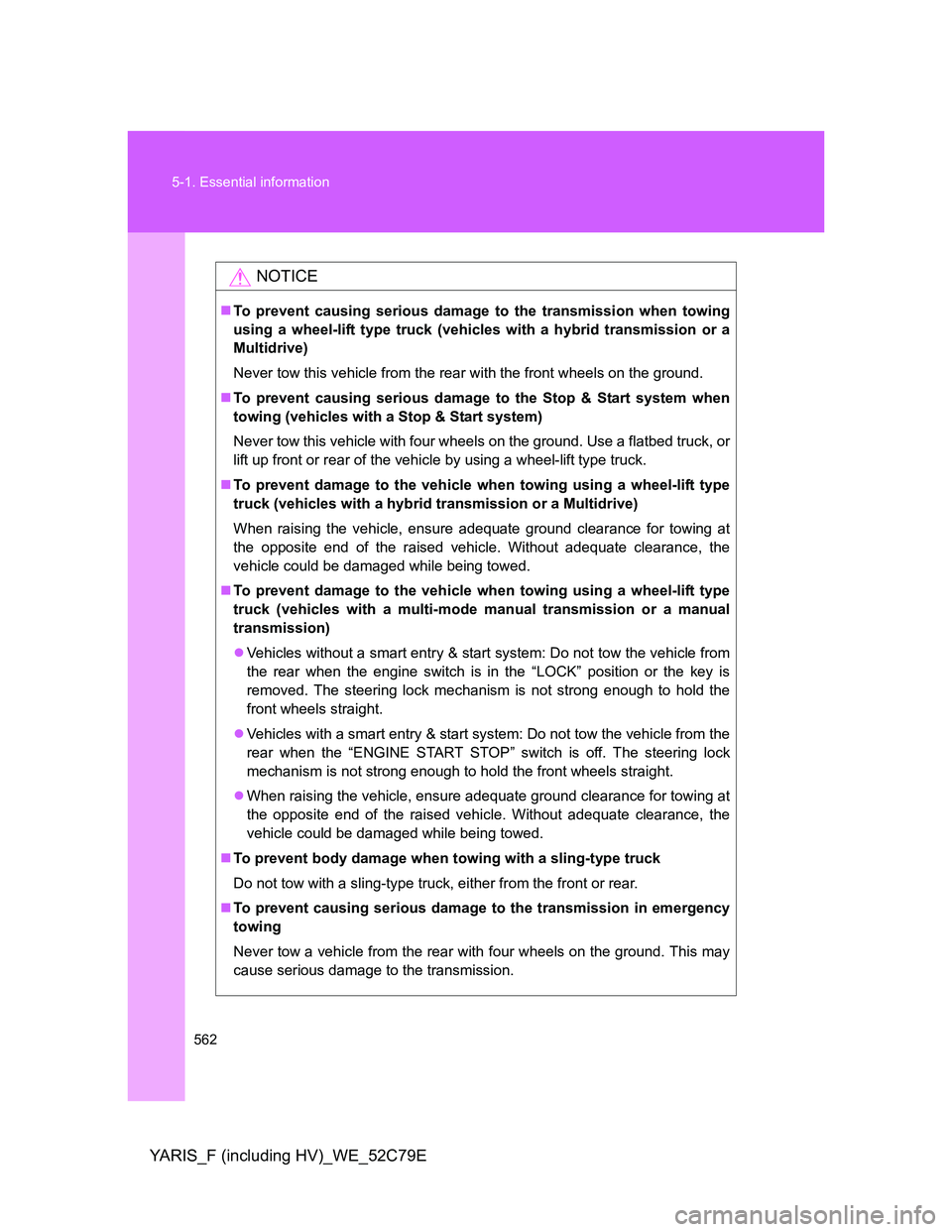
562 5-1. Essential information
YARIS_F (including HV)_WE_52C79E
NOTICE
To prevent causing serious damage to the transmission when towing
using a wheel-lift type truck (vehicles with a hybrid transmission or a
Multidrive)
Never tow this vehicle from the rear with the front wheels on the ground.
To prevent causing serious damage to the Stop & Start system when
towing (vehicles with a Stop & Start system)
Never tow this vehicle with four wheels on the ground. Use a flatbed truck, or
lift up front or rear of the vehicle by using a wheel-lift type truck.
To prevent damage to the vehicle when towing using a wheel-lift type
truck (vehicles with a hybrid transmission or a Multidrive)
When raising the vehicle, ensure adequate ground clearance for towing at
the opposite end of the raised vehicle. Without adequate clearance, the
vehicle could be damaged while being towed.
To prevent damage to the vehicle when towing using a wheel-lift type
truck (vehicles with a multi-mode manual transmission or a manual
transmission)
Vehicles without a smart entry & start system: Do not tow the vehicle from
the rear when the engine switch is in the “LOCK” position or the key is
removed. The steering lock mechanism is not strong enough to hold the
front wheels straight.
Vehicles with a smart entry & start system: Do not tow the vehicle from the
rear when the “ENGINE START STOP” switch is off. The steering lock
mechanism is not strong enough to hold the front wheels straight.
When raising the vehicle, ensure adequate ground clearance for towing at
the opposite end of the raised vehicle. Without adequate clearance, the
vehicle could be damaged while being towed.
To prevent body damage when towing with a sling-type truck
Do not tow with a sling-type truck, either from the front or rear.
To prevent causing serious damage to the transmission in emergency
towing
Never tow a vehicle from the rear with four wheels on the ground. This may
cause serious damage to the transmission.
Page 569 of 704

5
569 5-2. Steps to take in an emergency
When trouble arises
YARIS_F (including HV)_WE_52C79E
ABS warning light
Indicates a malfunction in:
• The ABS; or
• The brake assist system.
Electric power steering warning light (warning buzzer)
Indicates a malfunction in the EPS system.
Slip indicator light (if equipped)
Indicates a malfunction in:
• The VSC system;
• The TRC system; or
• Hill-start assist control.
(yellow
indicator)Brake system warning light (hybrid vehicle)
Indicates a malfunction in:
• The regenerative brake system; or
• The electronically controlled brake system.
(Flashes or
yellow
indicator)Cruise control indicator light (if equipped)
Indicates a malfunction in the cruise control system.
• Except hybrid vehicle: The light flashes to indicate a mal-
function.
• Hybrid vehicle: The light comes in yellow to indicate a mal-
function.
(Flashes)Stop & Start cancel indicator light (if equipped)
Indicates a malfunction in the Stop & Start system.
Fuel filter warning light (diesel engine only)
Indicate that the amount of accumulated water in the fuel
filter has reached the specified level. (P. 486)
(Flashes in
yellow for 15
seconds.)Smart entry & start system indicator light (If equipped)
Indicates a malfunction in the smart entry & start system.
Low traction battery indicator light (hybrid vehicle)
Indicates that the hybrid battery (traction battery) is low.
Warning lightWarning light/Details
Page 578 of 704
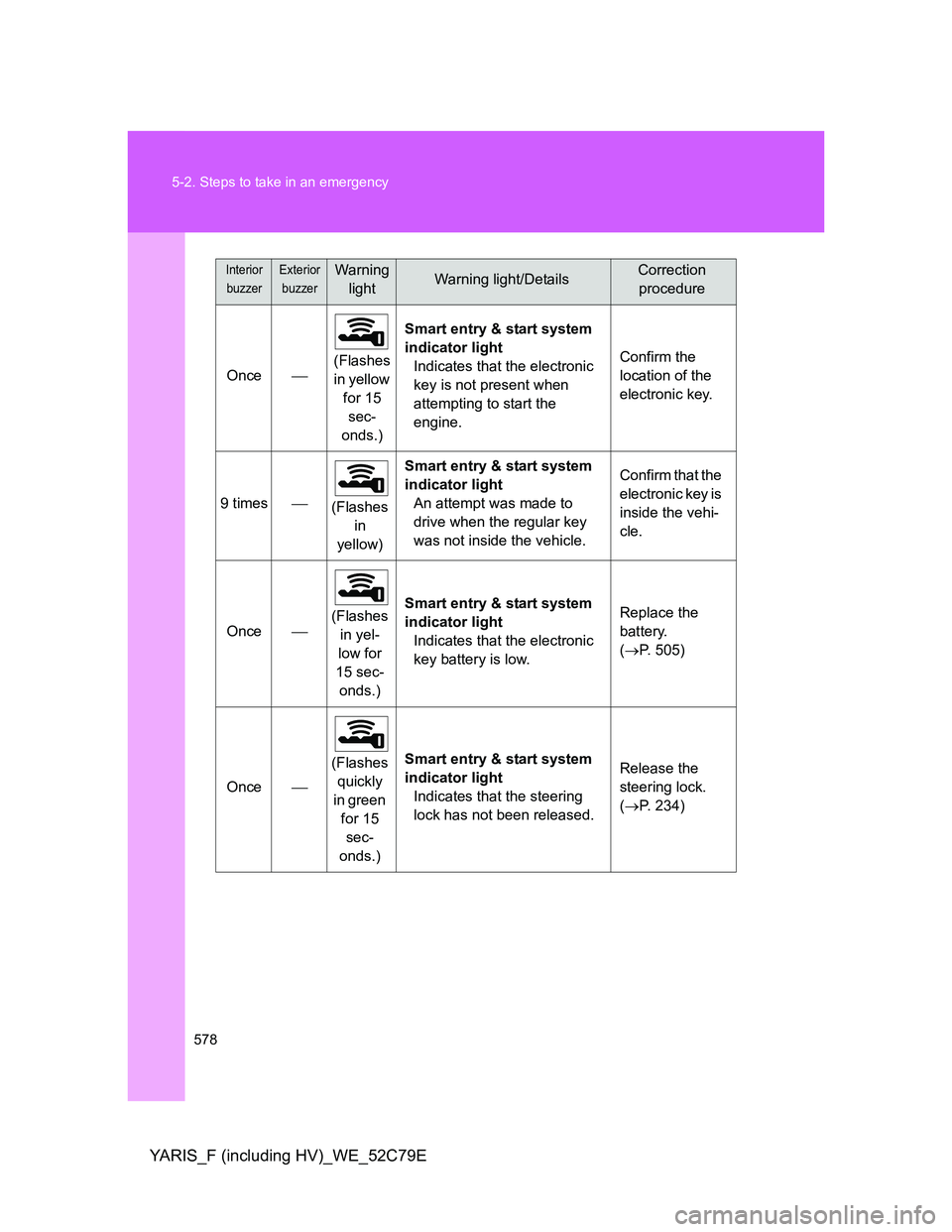
578 5-2. Steps to take in an emergency
YARIS_F (including HV)_WE_52C79E
Once(Flashes
in yellow
for 15
sec-
onds.)Smart entry & start system
indicator light
Indicates that the electronic
key is not present when
attempting to start the
engine.Confirm the
location of the
electronic key.
9 times
(Flashes
in
yellow)Smart entry & start system
indicator light
An attempt was made to
drive when the regular key
was not inside the vehicle.Confirm that the
electronic key is
inside the vehi-
cle.
Once(Flashes
in yel-
low for
15 sec-
onds.)Smart entry & start system
indicator light
Indicates that the electronic
key battery is low.Replace the
battery.
(P. 505)
Once(Flashes
quickly
in green
for 15
sec-
onds.)Smart entry & start system
indicator light
Indicates that the steering
lock has not been released.Release the
steering lock.
(P. 234)
Interior
buzzerExterior
buzzerWarning
lightWarning light/DetailsCorrection
procedure
Page 580 of 704

580 5-2. Steps to take in an emergency
YARIS_F (including HV)_WE_52C79E
Passenger detection sensor and passenger seat belt reminder
If luggage is placed on a passenger seat, the passenger detection sensor
may cause the warning light to flash even if a passenger is not sitting in
the seat.
If a cushion is placed on the seat, the sensor may not detect a passen-
ger, and the warning light may not operate properly.
Electric power steering warning light (warning buzzer)
Except hybrid vehicle: When the battery charge becomes insufficient or the
voltage temporarily drops, the electric power steering system warning light
may come on and the warning buzzer may sound.
Hybrid vehicle: When the 12-volt battery charge becomes insufficient or the
voltage temporarily drops, the electric power steering system warning light
may come on and the warning buzzer may sound.
If the malfunction indicator lamp comes on while driving
For some models, the malfunction indicator lamp will come on if the fuel tank
becomes completely empty. If the fuel tank is empty, refuel the vehicle
immediately. The malfunction indicator lamp will go off after several trips.
If the malfunction indicator lamp does not go off, contact any authorized
Toyota dealer or repairer, or another duly qualified and equipped profes-
sional as soon as possible.
If the engine oil change reminder light flashes (diesel engine with a
DPF system)
Repeated short trips and/or low-speed driving may cause the oil to degrade
sooner than usual, regardless of the actual distance driven. If this happens,
the engine oil change reminder light will flash.
Engine oil change reminder light comes on (diesel engine only)
Vehicles without a DPF system:
Replace the engine oil and oil filter when the engine oil change reminder
light does not come on even if you have driven over 40000 km (25000 miles)
after the engine oil was changed.
There is a possibility that the engine oil change reminder light has been illu-
minated when you have driven less than 40000 km (25000 miles) based on
a usage or driving condition.
Page 581 of 704

5
581 5-2. Steps to take in an emergency
When trouble arises
YARIS_F (including HV)_WE_52C79E
Vehicles with a DPF system:
Replace the engine oil and oil filter when the engine oil change reminder
light does not come on even if you have driven over 15000 km (9300 miles)
after the engine oil was changed.
There is a possibility that the engine oil change reminder light has been illu-
minated when you have driven less than 15000 km (9300 miles) based on a
usage or driving condition.
CAUTION
When the electric power steering system warning light comes on
The steering wheel may become extremely heavy.
If the steering wheel becomes heavier than usual when operating, hold
firmly and operate using more force than usual.
When driving to clean the DPF catalytic converter
When driving, pay sufficient attention to weather, road conditions, terrain and
traffic conditions, and be sure to observe traffic laws and/or regulations. Fail-
ure to do so may cause an unexpected accident, resulting in death or seri-
ous injury.
NOTICE
If the fuel filter warning light comes on (diesel engine only)
Never drive the vehicle with the warning light on. Continued driving with
water accumulated in the fuel filter will damage the fuel injection pump.
When the DPF system warning light comes on (diesel engine with a
DPF system)
If the DPF system warning light is left on without performing cleaning, after
an additional 100 to 300 km (62 to 187 miles), the malfunction indicator lamp
may come on. If this happens, have the vehicle inspected by any authorized
Toyota dealer or repairer, or another duly qualified and equipped profes-
sional immediately.
Page 591 of 704
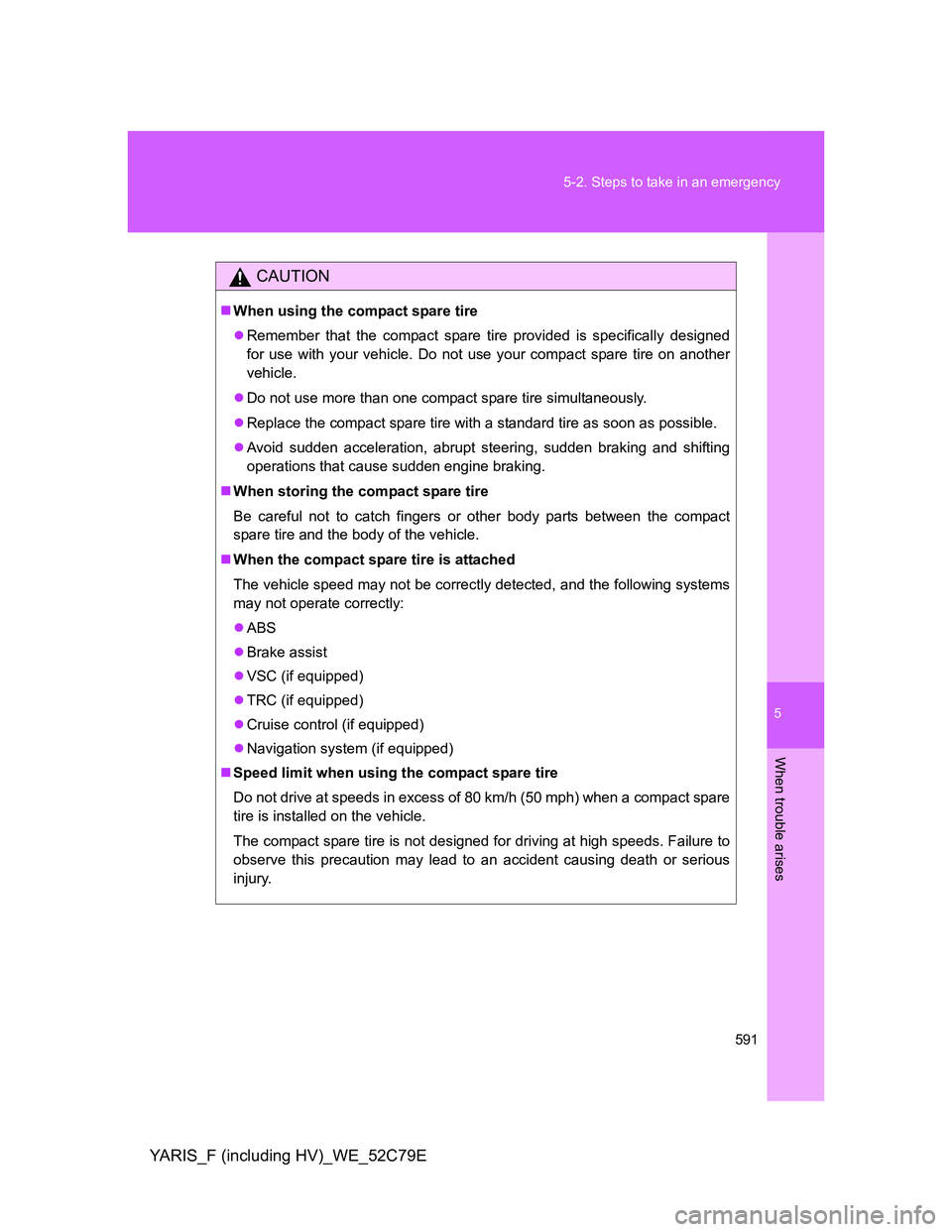
5
591 5-2. Steps to take in an emergency
When trouble arises
YARIS_F (including HV)_WE_52C79E
CAUTION
When using the compact spare tire
Remember that the compact spare tire provided is specifically designed
for use with your vehicle. Do not use your compact spare tire on another
vehicle.
Do not use more than one compact spare tire simultaneously.
Replace the compact spare tire with a standard tire as soon as possible.
Avoid sudden acceleration, abrupt steering, sudden braking and shifting
operations that cause sudden engine braking.
When storing the compact spare tire
Be careful not to catch fingers or other body parts between the compact
spare tire and the body of the vehicle.
When the compact spare tire is attached
The vehicle speed may not be correctly detected, and the following systems
may not operate correctly:
ABS
Brake assist
VSC (if equipped)
TRC (if equipped)
Cruise control (if equipped)
Navigation system (if equipped)
Speed limit when using the compact spare tire
Do not drive at speeds in excess of 80 km/h (50 mph) when a compact spare
tire is installed on the vehicle.
The compact spare tire is not designed for driving at high speeds. Failure to
observe this precaution may lead to an accident causing death or serious
injury.
Page 609 of 704
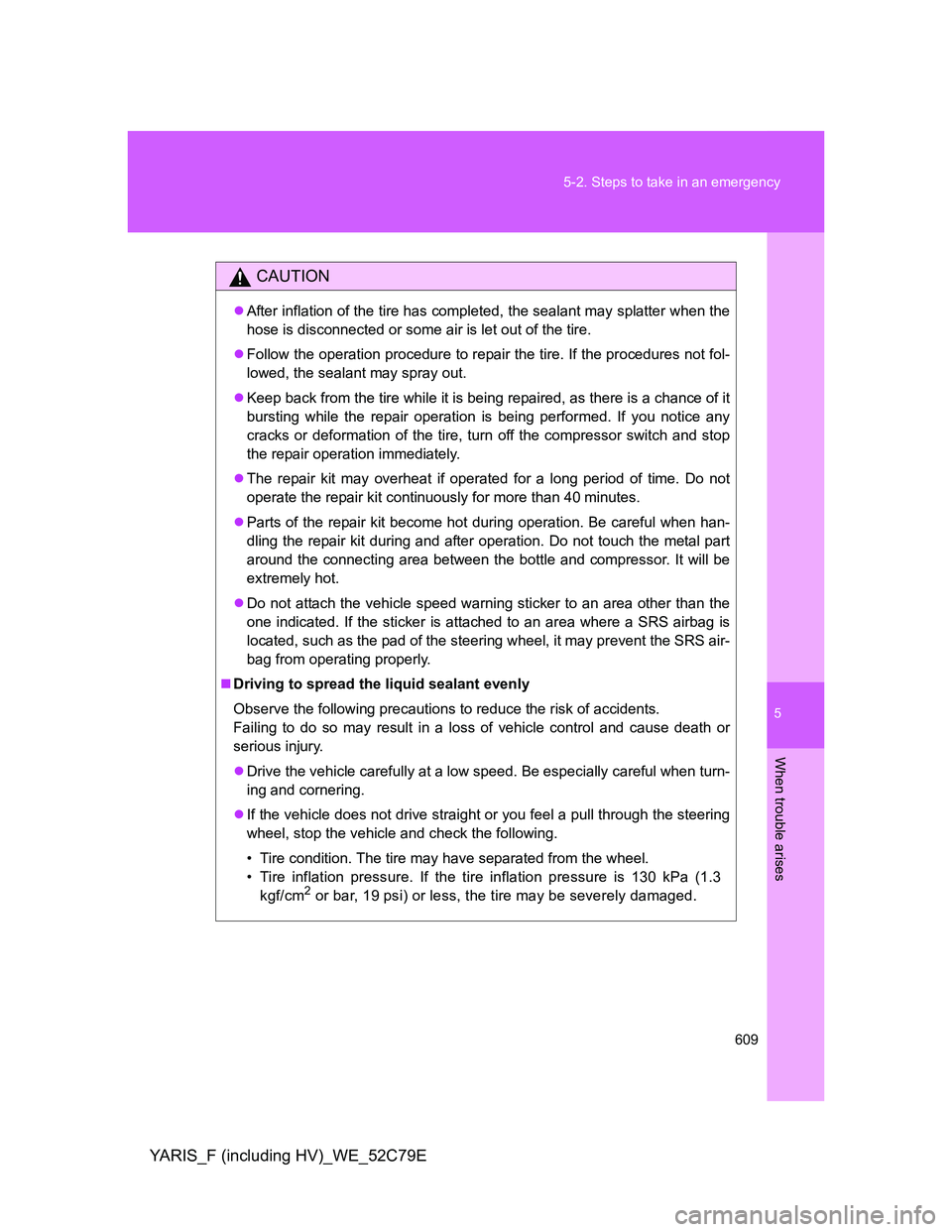
5
609 5-2. Steps to take in an emergency
When trouble arises
YARIS_F (including HV)_WE_52C79E
CAUTION
After inflation of the tire has completed, the sealant may splatter when the
hose is disconnected or some air is let out of the tire.
Follow the operation procedure to repair the tire. If the procedures not fol-
lowed, the sealant may spray out.
Keep back from the tire while it is being repaired, as there is a chance of it
bursting while the repair operation is being performed. If you notice any
cracks or deformation of the tire, turn off the compressor switch and stop
the repair operation immediately.
The repair kit may overheat if operated for a long period of time. Do not
operate the repair kit continuously for more than 40 minutes.
Parts of the repair kit become hot during operation. Be careful when han-
dling the repair kit during and after operation. Do not touch the metal part
around the connecting area between the bottle and compressor. It will be
extremely hot.
Do not attach the vehicle speed warning sticker to an area other than the
one indicated. If the sticker is attached to an area where a SRS airbag is
located, such as the pad of the steering wheel, it may prevent the SRS air-
bag from operating properly.
Driving to spread the liquid sealant evenly
Observe the following precautions to reduce the risk of accidents.
Failing to do so may result in a loss of vehicle control and cause death or
serious injury.
Drive the vehicle carefully at a low speed. Be especially careful when turn-
ing and cornering.
If the vehicle does not drive straight or you feel a pull through the steering
wheel, stop the vehicle and check the following.
• Tire condition. The tire may have separated from the wheel.
• Tire inflation pressure. If the tire inflation pressure is 130 kPa (1.3
kgf/cm
2 or bar, 19 psi) or less, the tire may be severely damaged.